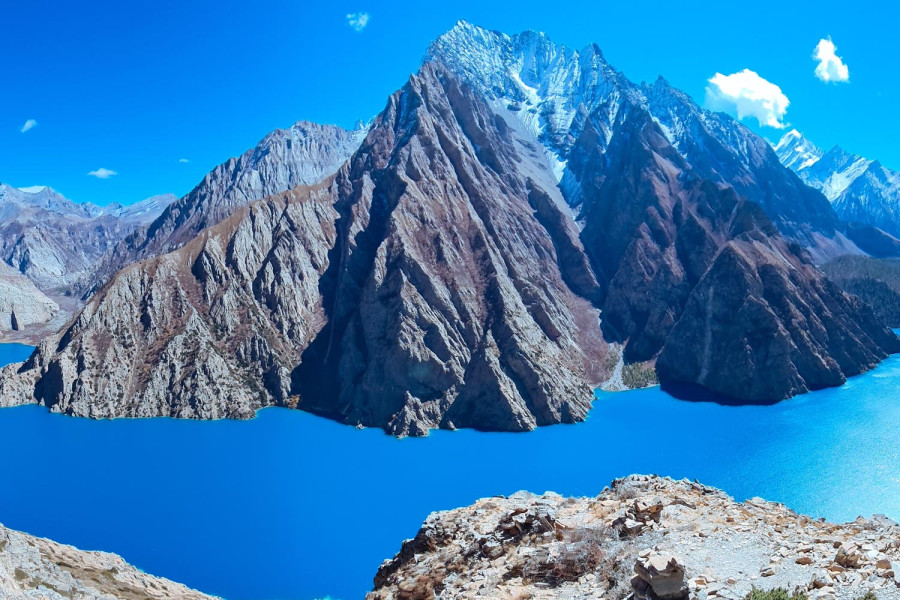Money
Karnali draws investment in tourism
Senior ophthalmologist Dr Sanduk Ruit recently visited Dolpa and suggested that the Shey Phoksundo area could be developed into a UNESCO World Heritage Site.
Jyotee Katuwal
Investment in businesses ranging from small tea shops to star hotels is increasing in Karnali due to tourism development. Medium and large hotels are opening in Birendranagar.
A hotel is under construction with an investment of Rs1.1 billion in Murmatop of Rara, funded by non-resident Nepalis and the IME Group. Additionally, hotel openings along the Karnali Highway are also on the rise. Pauwa and Valley View hotels are expanding their branches to Jumla, creating jobs for local residents.
Padam Bahadur Shahi, president of the Karnali Province Chamber of Commerce and Industry, said that the hospitality sector is becoming a key source of employment and economic support in Karnali, alongside traditional crops that yield quick benefits.
Despite immense tourism potential, Karnali lags behind in infrastructure development. Shahi said there is a need for better tourism infrastructure to make the region economically active. “This region has the potential to generate substantial revenue,” he added.
Hotels such as Siddhartha, Suva, Valley View, Namaste Nepal, and The Namaste are already established in Surkhet. Additionally, dozens of quality restaurants have opened, increasing local consumption and providing employment for youths in their hometowns.
Karnali has witnessed increased trade and business activities, including road network expansion and tourism promotion. In the first five months of the current fiscal year, Rs1.18 million in royalties was collected from visitors to the Shey Phoksundo lake in Dolpa.
Senior ophthalmologist Dr Sanduk Ruit, who recently visited Dolpa, was impressed by the region's tourism potential. During his visit for an eye camp, Ruit suggested that the Shey Phoksundo area could be developed into a UNESCO World Heritage Site. The Shey Phoksundo Rural Municipality has started efforts toward this goal, coordinating with the Department of Archaeology.
Tourists are drawn to Dolpa’s pristine environment, Himalayan lifestyle, and unique culture.
According to the Ministry of Tourism, Industry, Forest, and Environment of Karnali Province, 1,822 domestic tourists, 20 tourists from South Asian Association for Regional Cooperation (SAARC) countries, and 323 tourists from other nations visited Dolpa in the current fiscal year.
Since the fiscal year 2019-20, as many as 16,414 tourists have visited Dolpa, generating significant revenue.
Domestic and international tourists travel to Mugu and Dolpa to see Rara Lake, Shey Phoksundo Lake, and Tripurasundari Temple. Known as the "jewel of Karnali," Rara—the largest lake in Nepal—is accessible via road and flights through Gamgadhi, the Mugu headquarters. The growing road network has significantly increased the number of annual visitors to Rara Lake.
Pilgrims also travel to the Limi Lapcha area of Humla to worship Mount Kailash and Manasarovar in the Tibet region. Those unable to reach Tibet perform their rituals from Limi Lapcha.
Humla’s Chief District Officer, Narayan Pandya, said there is a need for better tourism infrastructure, including a route to Manasarovar via Surkhet-Humla.
The Karnali region has many tourist destinations, including Dho Valley, Limi, Rara, and Shey Phoksundo. Other attractions, such as Kuvindedaha in Salyan, the Panchakoshi religious site in Dailekh, and Sinja Valley in Jumla, are also gaining popularity.
Increased tourism in Panchakoshi is partly attributed to the ongoing petroleum exploration project supported by the Chinese government. This project has boosted commercial activity and attracted domestic tourists.
Sinja Valley, recognised as the origin of the Nepali language and a cultural hub for the Khas-Arya community, has become a preferred destination for Nepali visitors exploring historical sites.
In Surkhet, attractions like Kakrebihar and Bulbule Lake draw many visitors. Kakrebihar has been restored, and the Bulbule Lake area has expanded with improved road access. Birendranagar Municipality reported that nearly 200,000 domestic and international tourists visited Kakrebihar and Bulbule Lake.
Except for the Humla headquarters, all district hubs in Karnali are connected to the national road network. Flight services are available from Nepalgunj and Surkhet to Dolpa, Talcha in Mugu, Jumla, and Simkot. These services enable access to remote Himalayan destinations.
Birendranagar has become a prime choice for visitors to the capital of Karnali Province, with popular spots including Sahid Park, Ghantaghar, Deutibajai, and Gadhi. In Dailekh, tourists visit Kotgadh, Bilaspur Temple, Panchadewal, Shirsthan, Navisthan, Kotila, Dhuleshwar, and Paduka.
The Department of Mines and Geology’s petroleum exploration project in Dailekh has also boosted tourism and commercial activity. Basna Thapa, director of Hotel Pine in Dailekh, said that the project has revitalised the region, increasing domestic tourism and trade.
Niraj Shrestha, Information Officer at the Ministry of Industry, Tourism, Forest, and Environment, stated that promoting and developing tourism destinations in Karnali continues to increase the influx of domestic and foreign tourists.




 26.12°C Kathmandu
26.12°C Kathmandu














